| |
VICTORIA'S SECRET: HER REAL FATHER WAS ANGLO-IRISH CATHOLIC SIR JOHN CONROY,
AND HER MOTHER WAS VICTOIRE OF SAXE-COBURG-SAALFELD.
|
|
When
the "Grandmother of Europe" went to meet her Maker in 1901,
she had done her duty for the British Empire....The queen officially acknowledged
9 children and 42 grandchildren, but in reality she had 10 children and 42 grandchildren.
The
Apostle Paul—who established true Christianity at Roma—had
women deacons and helpers. After the bitter experience of Queen Cleopatra, the Romans despised female rulers. In the Jewish religion, women had very few rights.
During the pagan
Roman persecutions of Christianity, female martyrs were more numerous
than males:
Greet Priscilla
and Aquila, my fellow workers in Christ Joshua, who risked their
own necks for my life, to whom not only I give thanks, but also
all the congregations of the nations. Likewise greet the congregation
that meet in their house (Romans 16:3-5).
As
Saint Paul's missionary career was coming to an end, the Holy Spirit
revealed to him that time would not end when the great Temple in Jerusalem
was destroyed by the Romans. Consequently, being not ignorant of Satan's
devices, he began to prepare the Christians for the enemies they would
confront before the real end of the world. The Apostle especially
warned them about counterfeit "Jews" and the usurped role
of women:
But
I do not permit a woman to teach, nor to usurp
authority over a man, but to be in silence (I
Timothy 2:12).
Here is the advice
that Saint Paul gave to the future young Christian women:
So
I counsel younger women to marry, to have children, to manage their
homes and to give the enemy no opportunity for slander (I
Timothy 5:14).
It
was King Henry's lack of a male heir that launched the blessed Reformation
in England. Henry knew that the Bible prohibited incestuous marriages
. . . and female sovereigns. In the English language, the word QUEEN means the wife or spouse of a king.
Sir
John Conroy was the real father of Queen Victoria!!
Before
the Roman invasion of Britannia in 43 AD, the Britons always figured
genealogy from the female line because they knew that no father could
be sure that he was the true parent. Monogamous marriages were unheard
of, as males had women in common, and diabolical mother-son unions were quite common.
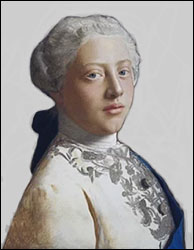
George Prince of Wales
(1762–1830). |
| |
In
December 1785, the Prince of Wales was secretly married
to Papal Maria Fitzherbert.
Femme
fatale Maria had already buried 2 husbands.
The
illegal marriage was first performed by a Jesuit priest
and later by a bribed Anglican clergyman.
The
marriage violated 2 Acts of Parliament. |
|
, |
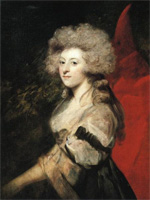
Maria Fitzherbert
(1767–1837). |
The first violation was the Act of Settlement of 1701 which was introduced after the Warming Pan Prince of Wales Plot. The second constitutional block was the Royal Marriage Act of 1772 which prohibited any royal marriage without the consent of good King George III.
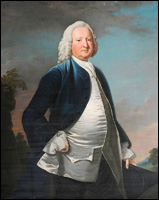
Sir Watkin Williams-Wynn
(1692–1749).
|
| |
Their top secret baby boy was born on October 21, 1786, on the Welsh estate of Sir Watkin Williams-Wynn.
The deceased Wynn was a fanatical supporter of the Jacobites!
Baby John was subsequently planted with the ultra-Catholic Conroy family from Ireland! |
|
|

The Wynnstay estate circa 1793.
|
The Prince of Wales and Maria decided to have their baby in Wales . . . so he would be a true PRINCE OF WALES:
When
not in Brighton the couple visited various country homes that their
owners had put at their disposal: Gloucester's house at Bagshot, Lord
North's at Bushey, and Wynnstay, the Welsh estate of Sir Watkins Williams
Wynn which they visited in late August. Maria's family also continued
to enjoy their new found status. As was his wont, Horace Walpole dipped
his pen in venom as he described a party at the house of Lady Clifford,
Maria's first cousin. (Munson, Maria Fitzherbert,
pp. 178-179).
John was named after Maria's brother John Smythe. Baby
John was adopted by the Anglo-Irish Conroy family who were living in
Wales at that time. According to their Papal genealogy, that would make
John the "Prince of Wales." By the end of October the couple
arrived back in London.
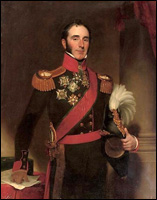
Sir John Conroy
(1786–1854).
|
| |
Sir
John Conroy—the real father of Queen Victoria—was
the son of the Prince of Wales and Maria Fitzherbert.
Conroy
was a captain in the British army until he was knighted
in 1827.
By
1817, Captain Conroy and his wife Elizabeth were the parents
of 5 children.
|
|
|
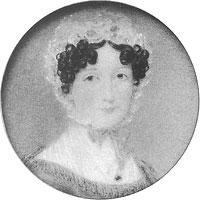
Lady Elizabeth
Conroy
(1791–1864).
|
The Conroy family
originated in County Roscommon, and he had an ancestor
who fought with King James II at the Battle of the Boyne. The Conroy family had
a massive 44 generations genealogy linking them to the ancient High Kings
of Ireland. There were more than a few Jesuit priests in their genealogy:
The Conroy family
then, so Edward tells us, came of Milesian stock and traced its descent
from Maine, the son of Niall of the Nine Hostages, Monarch of Ireland,
in AD 400. From thence the family's slow emergence from the mists
of Roscommon reads like a child's history of Ireland.
(Hudson, A Royal Conflict: Sir John Conroy and the Young Victoria,
p. 23).
Since the abolition
of the Irish Parliament and the
Act of Union in 1800, Papal John Conroy felt that he had more right to the British throne than the German Hanovers!
Prince
Edward, Duke of Kent, surrogate father for Queen Victoria, was the 4th
son of King George III. The duke and Julie de St. Laurent lived in Brussels,
Belgium, but the duke was definitely not heir conditioned.
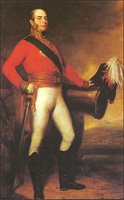 Prince Edward,
Duke of Kent
Prince Edward,
Duke of Kent
(1767–1820). |
| |
In
Nov. 1817, 50-year-old Prince Edward, Duke of Kent and
Strathearn, was living with his French mistress Julie
in Brussels, Belgium.
The
couple lived together for 27 years but the sterile
duke was childless.
The
duke was heavily in debt, so Parliament offered him the
princely sum of £25,000 per annum if he would marry the
widowed Princess Victoire of Saxe-Coburg-Saalfeld and
produce an heir to the throne. |
|
|
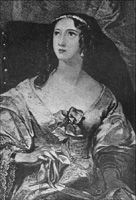 Julie de St.
Laurent
Julie de St.
Laurent
(1760–1830).
|
The
couple could not marry because Julie was considered a "commoner."
British "royalty" will always find an excuse to break the
10 Commandments.
The
greedy duke took the bait and proposed marriage to Princess Victoire.
From being broke and in debt, he now found himself a very rich man indeed:
By
March, the Duke of Kent had accumulated the astonishing sum of £15,000
through loans, bonds, and gifts. He wrote to the prince regent to
send the royal yacht to Calais for him and his wife. Dreading criticism
from the papers for ill-treating his brother, the prince reluctantly
agreed.
(Williams, Becoming Victoria, p. 155).
The
couple were married on May 29, 1818, at Amorbach, Bavaria. The marriage
ceremony was repeated on July 11, 1818, at Kew Palace, London. "Baby
Victoria" was born on May 24, 1819, in Kensington Palace. She was
named after her mother (English spelling of the French Victoire).
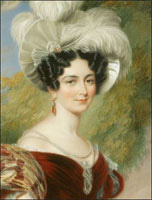
Victoire of Saxe-Coburg-Saalfeld.
(1786–1861).
|
| |
Parliament's
offer of £25,000 per annum to the duke was contingent
on him producing an heir to the throne.
That
is when Captain Conroy volunteered to become
his equerry.
Captain
Conroy and femme fatale Princess Victoire were
lovers and the real parents of baby Victoria.
|
|
|
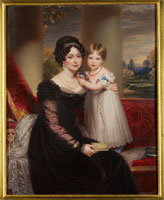
Victoire and baby Victoria holding
a miniature of her surrogate father. |
The surrogate father
never lived to see baby Victoria grow up because he died suddenly of
"influenza" on Jan. 20, 1820. The huge bribe was not enough
to guarantee his silence so he had a timely demise
because "dead men tell no tales."
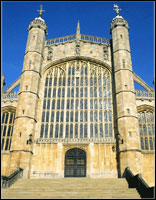 The final resting
place of the Duke of Kent, Windsor Castle, Berkshire.
The final resting
place of the Duke of Kent, Windsor Castle, Berkshire.
|
| |
The
Duke of Kent had a timely demise just 8 months
after the birth of baby Victoria!
Conroy
the "Catholic" and Victoire were
very anxious to create a regency were they would rule
together until daughter Victoria reached 18.
No
matter how hard his doctors tried to poison him, King
William IV was determined to hold out until Victoria reached
18.
|
|
|
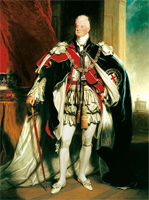 King William
IV (1765–1837).
King William
IV (1765–1837).
King from 1830 until 1837.
|
King William IV was the last Hanoverian sovereign. The
king referred to Conroy as "King Conroy" and he was well aware
of the conspiracy to replace him with a Papal sovereign.
The king was a military
man and he begged his doctors to let him live until June 18, the anniversary
of the Battle of Waterloo. His wish was granted when he went to meet
his Maker on June 20, 1837. The battle for control of the British throne
was indeed intense during that time.
After the death
of the duke, Victoria was raised at Kensington Palace by her mother
and Captain Conroy. Conroy felt that his "special status"
entitled him to a knighthood:
Now
that Victoria was second in line to the throne, Conroy pressed his
devoted Princess Sophia to suggest to her brother the king that he
and Lehzen should receive titles because a princess possessed of such
great position should not be served by commoners. George IV agreed,
and since he was king of Hanover, he made Lehzen a Hanoverian baroness
and Conroy a knight commander of the Hanoverian Order. The humble
Irish soldier became the elevated Sir John Conroy. Everything was
falling into place. (Williams, Becoming Victoria,
p. 202).
That
title was duly granted by King George IV in 1827 and "commoner"
Conroy became Sir John Conway, and his wife became Lady Elizabeth Conroy.
Victoria
was crowned queen on June 28, 1837
The
Hanoverian dynasty had a reputation for longevity. None of them suffered
from hemophilia, and none of them were artistically inclined. They were
also very, very tall while the queen was short and plumb.
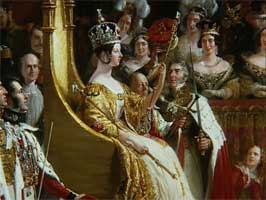 The crowning of Queen
Victoria
The crowning of Queen
Victoria
on June 28, 1837. |
| |
The
18-year-old Victoria was crowned queen in Westminster
Abbey on June 28, 1837.
Her
grandmother was Maria Fitzherbert.
Everyone
was astonished at the diminutive stature of the 4 feet
11 inch queen.
|
|
|
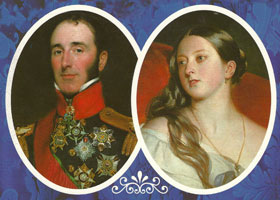 A candid
portrait of father
A candid
portrait of father
and daughter together.
|
Perhaps she
reminded them of the "Little Corsican" Napoleon Bonaparte.....The
name Victoria is Latin for
Nike and it means conqueror. There is no English
word for a female sovereign. The word queen meant the wife
of a king.
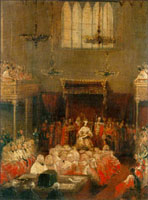 Victoria presiding
at the opening
Victoria presiding
at the opening
of Parliament in 1837. |
|
A
woman riding the beastly political system was the very
vision of the nightmarish end times given by the Apostle
John in the Apocalypse!
|
|
|
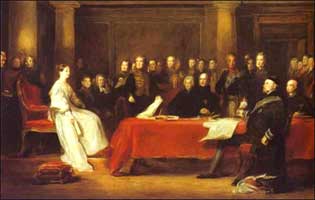 Victoria
was the perfect puppet as she
Victoria
was the perfect puppet as she
presided at her first Privy Council
meeting in 1837. |
The
young queen, with no prior political experience whatsoever, was in
over her head. She was not even a bluestocking as her favorite
pastime was collecting and dressing dolls. She relied completely on
the "advise" of her Privy Council and Prime Minister Melbourne.
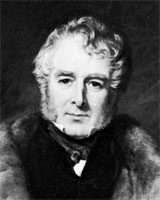 Lord Melbourne (1779–1848).
Lord Melbourne (1779–1848).
Prime minister from '34 to 1841. |
| |
Queen
Victoria was like potter's clay in the hands of the
shrewd Lord Melbourne.
The
main foreign policy objective of Lord Melbourne was
to avenge the defeat at the Battle of New Orleans and
prevent the New Jerusalem from expanding from
sea to shining sea.
In
1839, one of her ladies-in-waiting, Flora Hastings,
had a timely demise!!
|
|
|
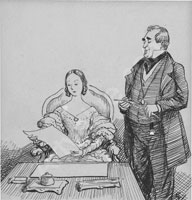 Lord Melbourne
"advising" Queen Victoria.
Lord Melbourne
"advising" Queen Victoria. |
The
queen looked up to Melbourne as a father figure and no romance was
involved. However, in 1839, a scandal erupted called the Flora Hastings
affair which involved Sir John Conroy, Lord Melbourne, and Queen Victoria.
The answer to the scandal was to find Victoria a husband and make
her less dependent on her parents. Unlike a normal courtship, she
had to propose marriage to him.
Queen
Victoria chose Prince Albert as her husband in 1840!!
When
Abraham sought a bride for his son Isaac, he sent his servant Eliazar
to Abraham's birthplace in Mesopotamia (Genesis Ch. 24). He met a
maiden named Rebekah and asked her if she was willing to be Isaac's
bride. She consented and returned with him to Canaan. On the other
hand, Victoria chose her husband.
As
her husband, Victoria chose Prince Albert of Saxe-Coburg and Gotha,
a small German principality. Victoria and Albert were first cousins
as his father was the brother of Queen Victoria's mother. Such consanguineous
marriages are prohibited by the Bible.
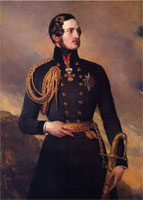
Prince Consort Albert
(1819–1861). |
| |
Victoria
chose Prince Albert—her first cousin—as
her husband.
The
couple were married on February 10, 1840, at St. James's
Palace, London, and she expected him to act like a submissive
wife.
To
her dismay, the prince gradually took over the role played
by Lord Melbourne.
|
|
|
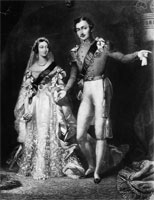
Victoria and Albert on
their wedding day.
|
Parliament
would not make him a king so he had to settle for the title: prince
consort. A man who embraced peace and progress, he was responsible
for the 1851 Great Exhibition held at the Crystal Palace in London.
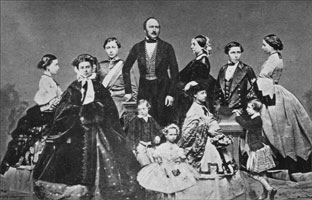 Victoria,
Albert, and their 9 children.
Victoria,
Albert, and their 9 children. |
| |
A
peace-loving German, he made powerful enemies when the
opposed the Crimean War.
At
the start of the U.S. Civil War the couple had 9 children.
The
U.S. Civil War was just a continuation of the Crimean
War and Lord Palmerston was determined to exact revenge
for that defeat. |
|
|
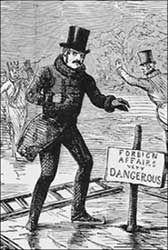
A cartoon in The Times warning the prince consort to
stay out of foreign affairs. |
During
the Crimean War he constantly urged his wife to frustrate the demands
of the belligerent Palmerston. That was tantamount to signing his
own death warrant.
When
the Civil War started, Lord Palmerston was absolutely determined to
aid his Confederacy, and the false flag operation was called the Trent Affair.
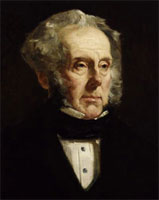
Lord Palmerston (1784–1865).
Prime Minister from 1855 to 1865. |
| |
During
the height of the Trent
Affair, the prince consort passed away of "typhoid
fever" on December 14, 1861.
Dr.
William Jenner was the queen's personal physician and
an expert on the prevention of typhoid
fever.
Incredibly,
this same Dr. Jenner would accompany the queen on her
incognito visit to Switzerland in 1868. |
|
|
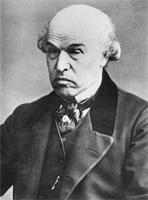
Dr. William Jenner
(1815–1898).
|
Doctors
can be deadly indeed. The changing of a belligerent letter to President
Lincoln by the prince consort changed the course of history . . . and cost
him his life.
After
the timely demise of her loving husband, the queen played the role
of "grieving widow" for the rest of her life.
John
Brown–the Scottish Rasputin!!
About
5 years after the death of her "beloved," the queen found
a new love in Balmoral, Scotland. Balmoral was remote from London
and far from the prying eyes of the public:
Balmoral
she liked best of all; or rather it was here that she was least unhappy.
Six hundred miles from London and twenty from the nearest railhead,
Balmoral suited her very well. To the annual autumn visit from early
September to late November she added a late spring visit lasting through
May and June. Amidst the desolate moors and rugged hillsides, she
could get right away from the public contact which she hated so much.
For even greater seclusion she retreated to little lodges among the
pine trees, where she would take tea or sit sketching. No matter how
tempestuous the weather, she ventured out. In spite of the fact that
her May and June visit took place during the parliamentary session,
she was always adamant about not changing her dates of arrival and
departure. Only a crisis of the most serious nature would induce her
to alter her plans by perhaps a day or two.
(Aronson, Heart of a Queen, p. 136).
His
name was John Brown and he became the constant companion of the queen.
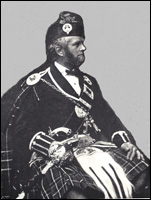
John Brown
(1826–1883). |
| |
John
Brown—Rasputin in a kilt—helping the "grieving
widow" to forget her sorrow.
He
became her constant companion and people began to refer
to the queen as "Mrs.
Brown."
John
Brown assumed the role of the late prince consort as her
adviser on political questions. |
|
|
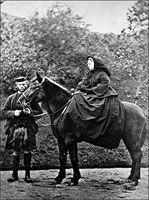
"Stallion Brown" holding
the queen's horse. |
Some
of the indiscreet local people even reported the queen and "commoner"
Brown romping together in the heather. How the queen wished that her
Scottish subjects would be as indiscreet as her Swiss. British sovereigns
frequently took mistresses, but for a woman to do the same was frowned
upon in Victorian England.
Queen
Victoria's top secret 1868 Swiss vacation with John Brown!!
The
queen had grown so fond of John Brown that she invited him to accompany
her on a top secret weight reduction vacation in Switzerland.
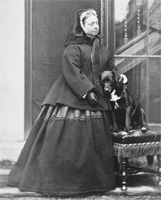
Queen Victoria in 1867. |
| |
Between
1867 and 1868 the queen suddenly gained a lot of weight
from eating Scotch porridge and haggis.
She
decided that trekking up and down the high Swiss mountains
would be the ideal weight reduction regimen.
Her
vacation was to be top secret and she was to
be known only as the Countess of Kent. |
|
|
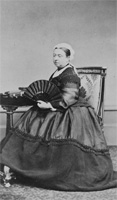
Queen Victoria in 1868, before
her weight reduction program.
|
Here
is the announcement that was made in July 1868 by British foreign
secretary, Lord Stanley:
The
Queen will leave England early next month for a short residence in
Switzerland. As Her Majesty goes abroad entirely on the recommendation
of her Physicians, in search of the change of air and repose which
they consider so essential to her health–she will maintain the
strictest incognita during her absence–refusing even
the visits, as well as the attentions usually paid to Sovereigns when
travelling on the Continent and in such circumstances. (Arengo-Jones,
Queen Victoria in Switzerland, p. 43).
The
planning and execution of the weight loss vacation was carried out
with military precision. The smallest details were not overlooked.
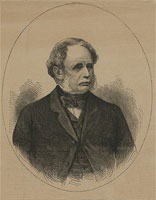
General Charles Grey.
|
| |
General
Charles Grey was the queen's private secretary.
Lord
Stanley was the British foreign secretary.
Incredibly,
Dr. William Jenner—the man who poisoned her husband—was
her personal physician during the vacation.
|
|
|
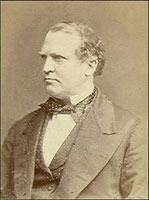
Lord Stanley
(1826–1893).
|
The
queen left Osborne House in the Isle of Wight on August 5 and crossed
via yacht to Cherbourg, France. Emperor Napoleon III provided his
special saloon train to take her to Paris. After a brief stopover
in Paris, she arrived in Lucerne, Switzerland, on August 7.
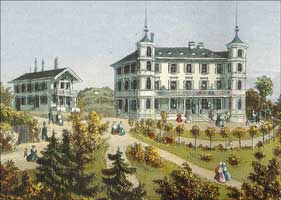
Villa Wallis in Lucerne where the queen
began her weight reduction program. |
| |
The
queen arrived in Lucerne on August 7 and stayed at the
Villa Wallis.
The
disappointed Swiss were not allowed to pay homage to their
sovereign aka Countess of Kent.
After
2 weeks in Lucerne, the queen felt challenged to seek
even "higher ground." |
|
|
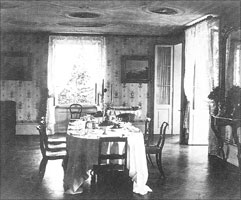
The Villa Wallis dining room at
the time of Victoria's visit. |
On
August 22, the queen left Lucerne for the much higher altitude of
the Furka Pass, well above the tree line, and far higher than the
queen had ever been before. Before her arrival, the Furka Inn was
emptied of guests, and no Swiss were allowed to get even close to
their queen.
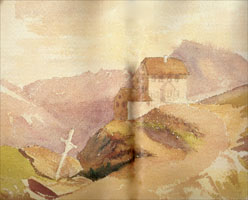 Furka Road
and Inn, watercolor
Furka Road
and Inn, watercolor
by Princess Louise.
|
| |
It
was during a 4-day stay at the high altitude Furka Inn
that the queen had her greatest weight loss.
On
the morning of August 25 her majesty was feeling much
lighter so she returned to Lucerne.
Victoria
was a good actor and talented artist so her
remaining days were spent painting the scenery of her
Swiss queendom.
|
|
|
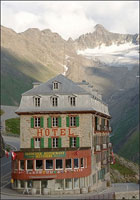 The Furka
Inn today.
The Furka
Inn today.
|
Victoria
was delighted that everything had gone so well and that her Swiss
subjects were the soul of discretion.
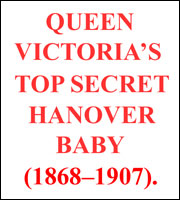
No photos exists of top secret
baby Klara Hanover.
|
| |
Queen
Victoria's Swiss baby was born on August 24—the
anniversary of the St.
Bart's Day Massacre.
The
baby was born in the high
altitude Furka Inn.
|
|
|

Klara Hanover
(1868–1907).
|
Feeling much lighter, she devoted
her remaining days admiring and painting the spectacular Swiss scenery.
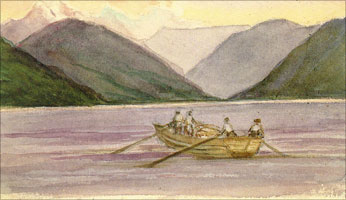 Rowing boat
on lake, watercolor by
Rowing boat
on lake, watercolor by
Queen Victoria, September 3, 1868.
|
| |
Queen
Victoria's health improved remarkably after her trip
up the mountain.
She
spent the remaining days of her vacation painting the
spectacular landscapes of her Swiss Confederation.
|
|
|
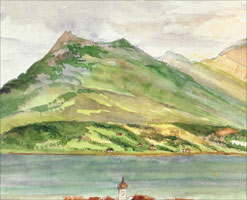 Rigi, watercolor
by Queen Victoria,
Rigi, watercolor
by Queen Victoria,
September 3, 1868. |
On
September 9, the queen, feeling much rested and lighter, took the
train back to Cherbourg:
It
was Emperor Napoleon III's saloon train, the same as on the outward
journey, that was now rattling its way towards Paris on the way back.
But whereas then, in early August, the Queen had not been able to
sleep at all, now she 'got a good deal of sleep during the night,'
and Lady Ely wrote to Disraeli from the British Embassy, where they
spent the day, that the Queen 'seems ... not in the least tired after
her journey.' (Arengo-Jones, Queen Victoria in
Switzerland. p. 130).
Vital
links
References
Aronson,
Theo. Victoria and Disraeli. The Making of a Romantic Partnership.
Macmillan Publishing Co, New York, 1977.
Aronson,
Theo. Heart of a Queen: Queen's Victoria's Romantic Attachments.
John Murray, London, 1991.
Aronson,
Theo. Prince Eddy and the Homosexual Underworld. John Murray,
London, 1994.
Aronson,
Theo. Grandmama of Europe: the Crowned Descendents of Queen Victoria,
Cassell, London, 1973.
Arengo-Jones, Peter. Queen Victoria in Switzerland.
Robert Hale. London, 1995.
Cullen,
Tom. The Empress Brown: the True Story of a Victorian Scandal.
Houghton Mifflin Co., Boston, 1969.
Duff, David.
Edward of Kent: The Life Story of Queen's Victoria's Father. Muller,
London, 1973.
Fairclough,
Melvyn, The Ripper and the Royals. Gerald Duckworth & Co.,
London, 1991.
Gillen, Mollie,
The Prince and His Lady: The Love Story of the Duke of Kent and Madame
de St. Laurent. Sidgwick & Jackson, London, 1970.
Hudson,
Katherine. A Royal Conflict: Sir John Conroy and the Young Victoria.
Hodder & Stoughton, London, 1994.
Munson, James. Maria
Fitzherbert: The Secret Wife of George IV. Carroll & Graf Publishers,
New York, 2001.
Norton, Elizabeth. She Wolves: The Notorious Queens of England. Hawthorne Books, Stroud, Gloucestershire, UK, 2014.
Potts,
D.M. & W.T. W. Queen Victoria's Gene: Hemophilia and the Royal
Family. Stroud, Sutton Publishers, 1999.
Spiering,
Frank.
Prince Jack: The True Story of Jack the Ripper. Jove Publication
Williams,
Kate. Becoming
Queen Victoria: The Tragic Death of Princess Charlotte and the Unexpected
Rise of Britain's Greatest Queen. Random House, New York, 2008.
Copyright
© 2021 by Patrick
Scrivener
Back
to Main Menu





































